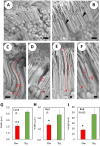Morphological analyses of the retinal photoreceptor cells in the nocturnally adapted owl monkeys
- PMID: 29375079
- PMCID: PMC5880819
- DOI: 10.1292/jvms.17-0418
Morphological analyses of the retinal photoreceptor cells in the nocturnally adapted owl monkeys
Abstract
Owl monkeys are the only one species possessing the nocturnal lifestyles among the simian monkeys. Their eyes and retinas have been interested associating with the nocturnal adaptation. We examined the cellular specificity and electroretinogram (ERG) reactivity in the retina of the owl monkeys by comparison with the squirrel monkeys, taxonomically close-species and expressing diurnal behavior. Owl monkeys did not have clear structure of the foveal pit by the funduscope, whereas the retinal wholemount specimens indicated a small-condensed spot of the ganglion cells. There were abundant numbers of the rod photoreceptor cells in owl monkeys than those of the squirrel monkeys. However, the owl monkeys' retina did not possess superiority for rod cell-reactivity in the scotopic ERG responses. Scanning electron microscopic observation revealed that the rod cells in owl monkeys' retina had very small-sized inner and outer segments as compared with squirrel monkeys. Owl monkeys showed typical nocturnal traits such as rod-cell dominance. However, the individual photoreceptor cells seemed to be functionally weak for visual capacity, caused from the morphological immaturity at the inner and outer segments.
Keywords: evolution; owl monkey; photoreceptor cell; retina; squirrel monkey.
Figures





Similar articles
-
Co-Opted Megasatellite DNA Drives Evolution of Secondary Night Vision in Azara's Owl Monkey.Genome Biol Evol. 2017 Jul 1;9(7):1963-1970. doi: 10.1093/gbe/evx142. Genome Biol Evol. 2017. PMID: 28810713 Free PMC article.
-
Horizontal cell morphology in nocturnal and diurnal primates: a comparison between owl-monkey (Aotus) and capuchin monkey (Cebus).Vis Neurosci. 2005 Jul-Aug;22(4):405-15. doi: 10.1017/S0952523805224033. Vis Neurosci. 2005. PMID: 16212699
-
M and P retinal ganglion cells of the owl monkey: morphology, size and photoreceptor convergence.Vision Res. 2001 Jan 15;41(2):119-31. doi: 10.1016/s0042-6989(00)00244-3. Vision Res. 2001. PMID: 11163848
-
The Owl Monkey (Aotus spp.) as an Animal Research Model-Part 1: Taxonomy, Geographic Distribution, Anatomy, and Behavior.J Med Primatol. 2025 Jun;54(3):e70022. doi: 10.1111/jmp.70022. J Med Primatol. 2025. PMID: 40275545 Review.
-
Grouped retinae and tapetal cups in some Teleostian fish: occurrence, structure, and function.Prog Retin Eye Res. 2014 Jan;38:43-69. doi: 10.1016/j.preteyeres.2013.10.001. Epub 2013 Oct 22. Prog Retin Eye Res. 2014. PMID: 24157316 Review.
Cited by
-
The Heterochromatin Block That Functions as a Rod Cell Microlens in Owl Monkeys Formed within a 15-Myr Time Span.Genome Biol Evol. 2021 Mar 1;13(3):evab021. doi: 10.1093/gbe/evab021. Genome Biol Evol. 2021. PMID: 33533923 Free PMC article.
References
-
- Deldar A.1998. Blood and bone marrow. pp. 62–79. In: Textbook of Veterinary Histology, 5th ed. (Dellmann, H. D. and Eurell, J. A. eds). Williams and Wilkins, Baltimore.
MeSH terms
LinkOut - more resources
Full Text Sources
Other Literature Sources

